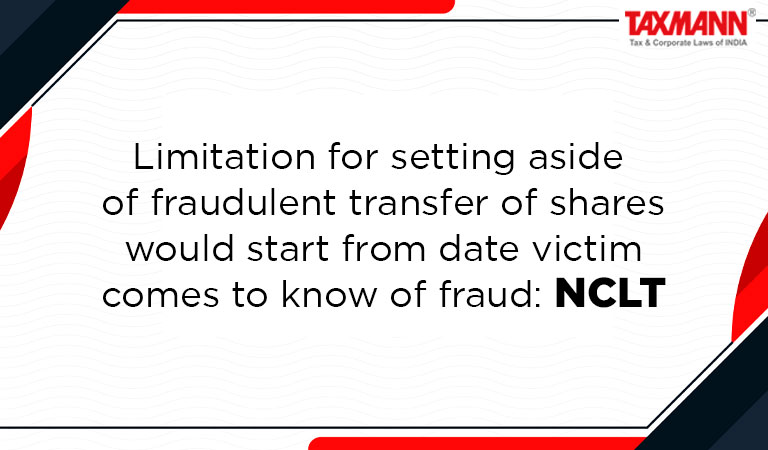Limitation for setting aside of fraudulent transfer of shares would start from date victim comes to know of fraud: NCLT
- Blog|News|Company Law|
- 2 Min Read
- By Taxmann
- |
- Last Updated on 5 November, 2022
Case Details: Mrs. Rizwana Anjum v. Hira Multi Construction Ventures (P.) Ltd. - [2022] 144 taxmann.com 81 (NCLT-Hyd.)
Judiciary and Counsel Details
-
- Dr. Venkata Ramakrishna Badarinath Nandula, Judicial Member & Veera Brahma Rao Arekapudi, Technical Member
- M.S. Prasad, Learned Sr. Counsel, Venkat Rami Reddy & Parameswara Reddy, Advs. for the Petitioner.
- Jagadeesh, S. Ravi, Learned Sr. Counsel & Sharad Sanghi, Advs. for the Respondent.
Facts of the Case
In the instant case, the petition was filed u/s 59 of the Companies Act, 2013 read with Rule 70 of the NCLT Rules, 2016, seeking relief to declare the impugned transfer of shares made in favour of the respondent as null and void and directions to bring back such shares. Also, directions to the respondent company to rectify the Register of Members and Directions to RoC, to invalidate the Annual Returns and other relevant forms.
The petitioner was allotted 2,500 shares in the respondent company and the same was reflected in the Annual Return for the year 2003. In the next year, another 2250 shares were transferred in favour of the petitioner, however the same was not reflected in the subsequent Annual Returns i.e. 2006, 2007 and 2008 filed. Also, the shareholding of the petitioner was shown as NIL in the Annual Returns filed for the years 2009 to 2018.
The petitioner contended that she had neither sold her shares to anyone nor had received any consideration for the transfer of such shares. The same was done fraudulently to gain benefits and to have control over the management of the company. Also, the annual statements of the respondent company were uploaded from time to time.
Further, the petitioner contented that the respondent company resigned a director by fraudulently annexing the forged resignation letters along with Form 32. Also, the petitioner stated that the alleged transfer of shares was effected by the respondent company without her knowledge in the year 2009.
It was noted that the present petition was filed in the year 2019 i.e. after a delay of 10 years, and thus was barred by limitation by virtue of section 433 of the Companies Act read with Article 137 of the Limitation Act. Further, the petitioner had not filed any application seeking condonation of delay.
NCLT Held
The National Company Law Tribunal (NCLT) held that mere uploading of the financial statements of the company in the Public website would be conclusive proof of ‘discovery of fraud’ by the suitor. Further, the limitation shall not begin to run from the date when the financial statements were so uploaded. Rather, the period of limitation shall began from the date on which the petitioner came to know the fraud played by the respondents.
Further, the NCLT held that the present petition was filed within three years of coming to know about the fraud played by the respondents. Accordingly, the petition was not barred by limitation.
Disclaimer: The content/information published on the website is only for general information of the user and shall not be construed as legal advice. While the Taxmann has exercised reasonable efforts to ensure the veracity of information/content published, Taxmann shall be under no liability in any manner whatsoever for incorrect information, if any.

Taxmann Publications has a dedicated in-house Research & Editorial Team. This team consists of a team of Chartered Accountants, Company Secretaries, and Lawyers. This team works under the guidance and supervision of editor-in-chief Mr Rakesh Bhargava.
The Research and Editorial Team is responsible for developing reliable and accurate content for the readers. The team follows the six-sigma approach to achieve the benchmark of zero error in its publications and research platforms. The team ensures that the following publication guidelines are thoroughly followed while developing the content:
- The statutory material is obtained only from the authorized and reliable sources
- All the latest developments in the judicial and legislative fields are covered
- Prepare the analytical write-ups on current, controversial, and important issues to help the readers to understand the concept and its implications
- Every content published by Taxmann is complete, accurate and lucid
- All evidence-based statements are supported with proper reference to Section, Circular No., Notification No. or citations
- The golden rules of grammar, style and consistency are thoroughly followed
- Font and size that’s easy to read and remain consistent across all imprint and digital publications are applied








